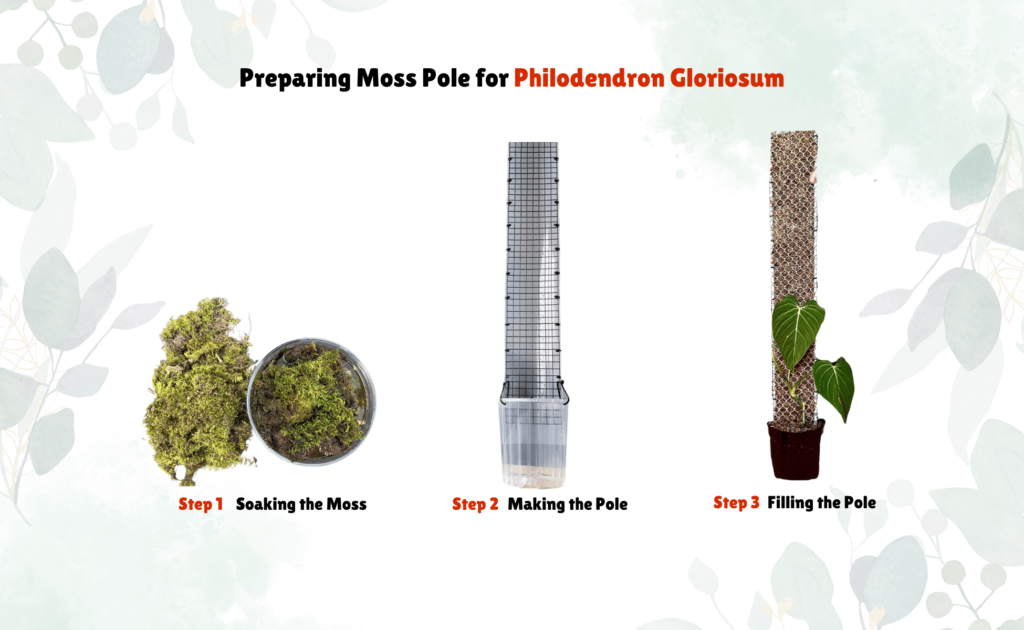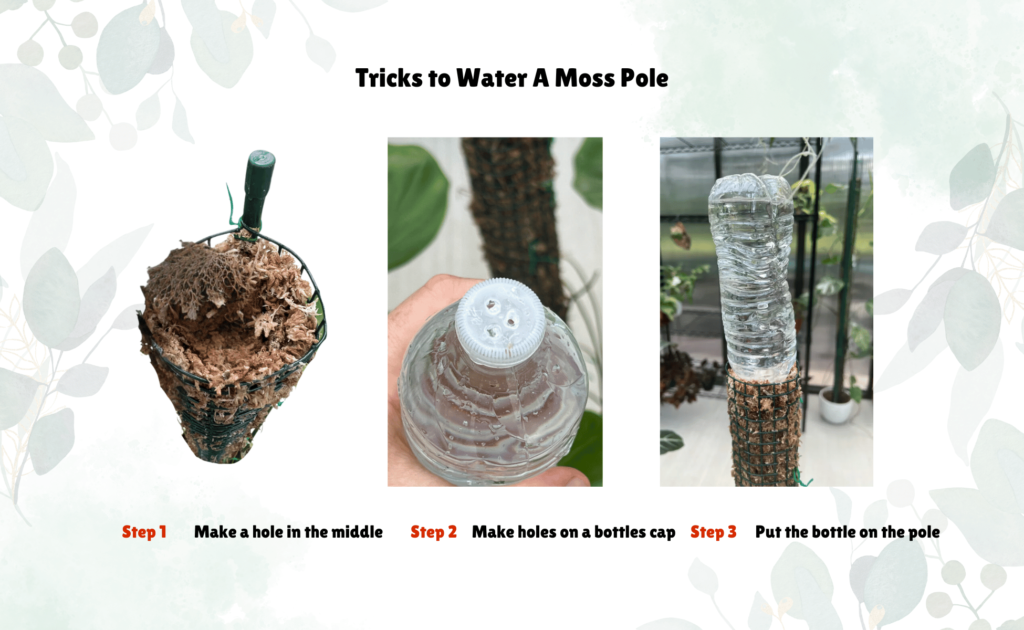Moss Pole for Philodendron Gloriosum: Grow Giant Leaves
Ever marveled at those Stunning, cascading vines of Philodendron Gloriosums on Instagram? The secret to their impressive growth lies in a simple yet powerful tool: the moss pole. Uncover the transformative effects it can have on your plant, opening up a whole new world of growth and beauty that will leave you in awe.
The Philodendron Gloriosum, with its lush, heart-shaped leaves and unique creeping growth habit, has earned a special place in the hearts of houseplant enthusiasts. While it naturally crawls, you can guide this plant to climb using a moss pole. This not only helps the Philodendron Gloriosum grow upright but also showcases its stunning foliage.
Moss poles are nature’s way of supporting the Philodendron Gloriosum’s climbing needs. By mimicking the plant’s natural environment, they provide the perfect support for your Gloriosum to develop larger, healthier leaves. When choosing and preparing the right moss pole, rest assured that you’re providing the best care for your plant.
Attaching your Philodendron Gloriosum to a moss pole is a simple yet effective way to encourage vertical growth. This improves the plant’s access to light and air circulation, promoting its overall health. Regular care, including misting and watering, ensures that your plant remains vibrant and healthy as it climbs.
Key Takeaways
- Moss poles help Philodendron Gloriosum grow upright and produce larger leaves.
- Choose a moss pole that matches your plant’s size and growth needs.
- Proper care includes regular misting and watering to maintain humidity.
Why Use a Moss Pole for Philodendron Gloriosum
Moss poles help the Philodendron Gloriosum grow as it would in the wild, guiding its upward climb. They also support the plant’s structure, encourage large leaves, and protect it from damage.
Mimics Natural Environment
Philodendron Gloriosum is a tropical houseplant that thrives in rainforests, using nearby trees and rocks as its climbing aids. A moss pole perfectly replicates this natural support system, providing a climbing surface that the plant’s aerial roots can grip, ensuring its well-being and health.
In the wild, climbing helps the plant reach light and humidity levels that suit its needs. By using a moss pole, you provide a similar structure, which benefits the plant’s health and growth.
The pole not only supports the plant but also creates a microclimate around it, maintaining the ideal temperature and humidity. This mimics the plant’s natural environment, promoting its overall health and growth.
Encourages Upright Growth
Philodendron Gloriosum tends to crawl along the ground. A moss pole can help it grow vertically, which saves space and keeps it from spreading too much.
Vertical growth also ensures that the plant’s leaves get more exposure to light. This can lead to healthier leaves and faster growth rates, making your plant more attractive.
Supports Larger Leaves
When Philodendron Gloriosum climbs, its leaves tend to become larger and more robust. This is because climbing enables the plant to reach more light and better air circulation.
Larger leaves are not just visually appealing; they indicate strong, healthy growth. The increased surface area of the leaves allows the plant to absorb more light, which is essential for photosynthesis.
This, in turn, fuels the plant’s growth and overall health. By supporting your plant with a moss pole, you encourage the development of these impressive leaves, ensuring your Philodendron Gloriosum remains a stunning addition to your collection.
Prevents Leaf Damage
Using a moss pole ensures the plant’s leaves are held upright and off the ground, significantly reducing the risk of leaf damage from pests and diseases. Leaves skating along the soil are more likely to get injured or dirty, but a moss pole provides a protective barrier, instilling confidence in the plant’s longevity.
Keeping the leaves elevated also prevents them from turning yellow due to poor air circulation or excessive moisture in the soil. This can improve the overall health and appearance of your plant, ensuring it remains a stunning addition to your collection.
Choosing the Right Moss Pole
To ensure your Philodendron Gloriosum thrives, selecting the proper moss pole is essential. You need to consider both the material and size of the moss pole to best support your plant’s growth.
Material
Wood vs. PVC: When choosing the material, think about the appearance and durability. Wood poles, such as those made from bamboo, offer a natural look that blends well with the plant’s aesthetic. PVC poles are more durable and resist rot, making them a long-lasting option but may not look as natural.
Coir vs. Sphagnum Moss: For the covering, Coir is a coarse fiber from coconut husks. It provides a sturdy structure but holds less moisture. Sphagnum Moss, on the other hand, is finer and retains more water, which can help keep your plant’s roots hydrated. Both types can support aerial roots, but sphagnum may be better if your area is dry. Consider these factors when choosing the type of moss for your pole.
Size
Matching the Plant’s Growth: The height of the moss pole is also important. Choose a pole that is slightly taller than your plant to accommodate future growth. This helps maintain the plant’s upright form and allows it to climb as it would in its natural habitat.
Additionally, consider the diameter of the pole. A thicker pole provides more stability for larger plants, while a thinner pole is suitable for smaller ones. By choosing a moss pole that matches your plant’s size and growth needs, you provide the best support for its development.
Extensions: Consider poles that offer extensions. As your Philodendron Gloriosum matures, you can add height to the existing pole without disturbing the plant. This flexibility ensures ongoing support as the plant reaches its full size. A well-supported plant will grow healthily and display its beautiful, large leaves prominently.
Preparing the Moss Pole
To prepare a moss pole for your Philodendron Gloriosum, you need to focus on soaking the moss and filling the pole. These steps ensure the moss holds moisture properly and provides adequate support for your plant.

Soaking the Moss
Start by soaking the sphagnum moss in water for about 20 minutes. This helps the moss absorb enough moisture to support the plant. Place the dry moss in a bowl or a bucket filled with water, ensuring it is fully submerged.
After 20 minutes, remove the moss and gently squeeze out the excess water. Make sure the moss is damp but not dripping. This step is crucial as overly wet moss can lead to root rot, while dry moss won’t provide enough moisture for the plant’s roots.
Filling the Pole
Once your moss is properly soaked, it’s time to fill the pole. Use a PVC pipe or a bamboo stick as the base for your moss pole. Start by securing one end of the pole, then begin wrapping the soggy moss around it tightly. As you wrap, make sure to press the moss firmly against the pole to ensure it adheres well. Continue wrapping until the entire pole is covered with moss.
Pack the moss evenly along the length of the pole. You can use a string or zip ties to secure the moss in place at intervals. Leave a small space at the top of the pole; this helps prevent the moss from falling off.
By properly preparing your moss pole, you ensure your Philodendron Gloriosum gets the support and moisture it needs to thrive. For more detailed steps, refer to this guide on preparing the moss pole.
Attaching Your Philodendron Gloriosum to the Moss Pole
Attaching your Philodendron Gloriosum to a moss pole helps you provide the necessary support for the plant to climb and grow. Proper attachment techniques ensure that the plant’s roots and stems remain healthy while encouraging vertical growth.
Gently Detangle Roots
Before attaching your Philodendron Gloriosum to a moss pole, carefully detangle the roots. Start by removing the plant from its pot and gently shaking off excess soil. Use your fingers to separate the roots, being careful not to break or damage them.
If the roots are densely packed, you can rinse them under lukewarm water to loosen the soil. Make sure the roots are clean and free from any dead or decaying matter. This step ensures that the plant can establish itself on the moss pole without any hindrance.
Position on the Pole
After detangling the roots, position the Philodendron Gloriosum on the moss pole. Place the base of the plant against the pole, making sure that the roots have contact with the moss. Position the plant so that its stem is aligned with the pole, allowing it to climb naturally.
Ensure that the roots are spread evenly around the base of the pole, and gently press them into the moss. This helps the aerial roots grow into the moss, providing the necessary support and nutrients for the plant.
Securing the Plant
To secure the Philodendron Gloriosum to the moss pole, use plant ties, Velcro strips, or twist ties. Start at the base of the plant and work your way up, gently tying the plant to the pole without damaging the stem or roots. Make sure the ties are snug but not too tight, as this can harm the plant.
Check the ties regularly and adjust them as needed to accommodate the plant’s growth. Over time, as the plant climbs the pole, its aerial roots will naturally anchor into the moss, reducing the need for additional support. Keeping the moss pole moist will encourage the roots to grow and attach more effectively.
Ongoing Care with a Moss Pole
To keep your Philodendron Gloriosum thriving with a moss pole, focus on proper watering, misting, and fertilizing. These practices ensure your plant receives the necessary support and nutrients, mimicking its natural habitat.

Watering
Watering both the soil and the moss pole is crucial. Ensure the soil is well-draining by using a mix that includes perlite or orchid bark. Water when the top inch of soil feels dry. Overwatering can lead to root rot, so use pots with drainage holes.
Keep the moss on the pole moist but not soggy. Mist it regularly to provide consistent humidity. This helps the aerial roots attach and absorb moisture. Always avoid letting the soil or moss dry out completely.
Misting
Regular misting is essential to maintain humidity, replicating the plant’s tropical environment. Mist the leaves and the moss pole a few times a week. This keeps the aerial roots hydrated and encourages them to cling to the moss pole.
Humidity levels should stay between 60% and 80%. You can use a humidity tray or a humidifier if your home is dry. High humidity also helps prevent common pests like spider mites, which thrive in dry conditions.
Fertilizing
Fertilize your Philodendron Gloriosum during the growing season, typically spring through summer. Use a balanced, diluted liquid fertilizer every 4-6 weeks. Apply the fertilizer to both the soil and the moss pole. This supports even growth and healthy foliage.
Avoid over-fertilizing, which can burn the plant’s roots and leaves. Always follow the instructions on the fertilizer package. Fertilizing boosts the plant’s growth, keeping your indoor jungle lush and thriving.
Troubleshooting Common Issues
You might face some challenges when using a moss pole for your Philodendron Gloriosum. Here are some common issues and straightforward solutions.
Plant Not Climbing
If your Philodendron Gloriosum is not climbing the moss pole, it may need a bit of encouragement. Start by gently guiding the aerial roots towards the moss pole. Use soft plant ties or Velcro strips to secure the stem to the pole.
Make sure the roots are in contact with the moss. Ensure the pole is steady and firmly planted in the pot.
Consider increasing the humidity around the plant, as higher humidity encourages aerial roots to attach more quickly. Regular misting can also help the roots to bond with the moss pole.
Moss Drying Out Too Quickly
Moss drying out fast can be a problem, especially in dry or low-humidity environments. First, try misting the moss pole more frequently. This helps to keep it adequately moist.
You can also increase the humidity around the plant. Place a humidifier near the plant or use a pebble tray filled with water under the pot.
Make sure to soak the moss pole well before installation. You can opt for sphagnum moss, which holds water longer than coir. Using well-draining soil in the pot can help retain moisture in the moss while preventing the roots from becoming waterlogged.
Moss Becoming Overly Soggy
If the moss on your pole is getting too soggy, you might be overwatering. Check the soil’s moisture level before watering. Allow the top inch of soil to dry out between waterings to prevent excess moisture.
Make sure your pot has good drainage holes. Well-draining soil is vital to avoid waterlogging, which can lead to root rot. You might also consider using a moisture meter to monitor the moisture levels in the moss and soil accurately.
To prevent the moss from staying too wet, avoid watering it directly. Focus on misting and let the pot’s soil naturally wick moisture into the moss.
Frequently Asked Questions
Using a moss pole can help your Philodendron Gloriosum grow stronger and healthier. Below are some common questions and their answers to assist you in getting the most out of your moss pole.
How can I effectively attach my Philodendron Gloriosum to a moss pole?
To attach your Philodendron Gloriosum, first, detangle any roots. Then, place the base against the pole, ensuring good contact between the roots and the moss. Secure the plant gently with plant ties or twist ties, being careful not to damage the stem or roots.
What benefits does a moss pole provide for Philodendron Gloriosum growth?
A moss pole supports taller growth and helps develop larger leaves by allowing the plant to mimic its natural climbing habit. This encourages better access to light and air circulation and keeps leaves off the ground, preventing damage and dirt accumulation.
Can a moss pole support the large leaves of Philodendron Gloriosum?
Yes, a moss pole can support the large leaves of Philodendron Gloriosum. The pole provides a stable anchor for the aerial roots, which helps hold up the heavy foliage, allowing the leaves to grow bigger and healthier.
What type of moss pole is best for a Philodendron Gloriosum?
Sphagnum moss poles are often best because they hold moisture well and provide a soft texture for roots to cling to. Coir moss poles are coarser and may not retain as much moisture, but they are durable and offer good support.
How often should I replace or extend the moss pole for my Philodendron Gloriosum?
You should replace or extend the moss pole when your Philodendron Gloriosum has outgrown it. This usually means when the plant reaches the top of the pole or starts to droop. Adding extensions is an option if you prefer not to replace the entire pole.
How should I care for my Philodendron Gloriosum as it starts to climb the moss pole?
As your Philodendron begins to climb, ensure the moss stays consistently moist but not soggy. Mist the pole regularly and provide bright, indirect sunlight. Water the soil and apply a diluted liquid fertilizer during the growing season to promote strong, healthy growth.

